Friendly Fire
Syrian Women and the “Arms and Violence” Syndrome
Linda Bilal
This investigation was conducted at Ma`r-Tahrama, in the southern countryside of Idlib governorate, western Syria. It aims at highlighting how the proliferation of fire arms is reflected in the heightened levels of violence against women. Syria witnessed a bitter widespread war since late 2011, after the Syrian Revolution erupted. Ma`r-Taharma was amongst the first to take part in the uprising, and thus came under heavy fire from the Syrian regime and its allies, as well as extremist Islamic factions.
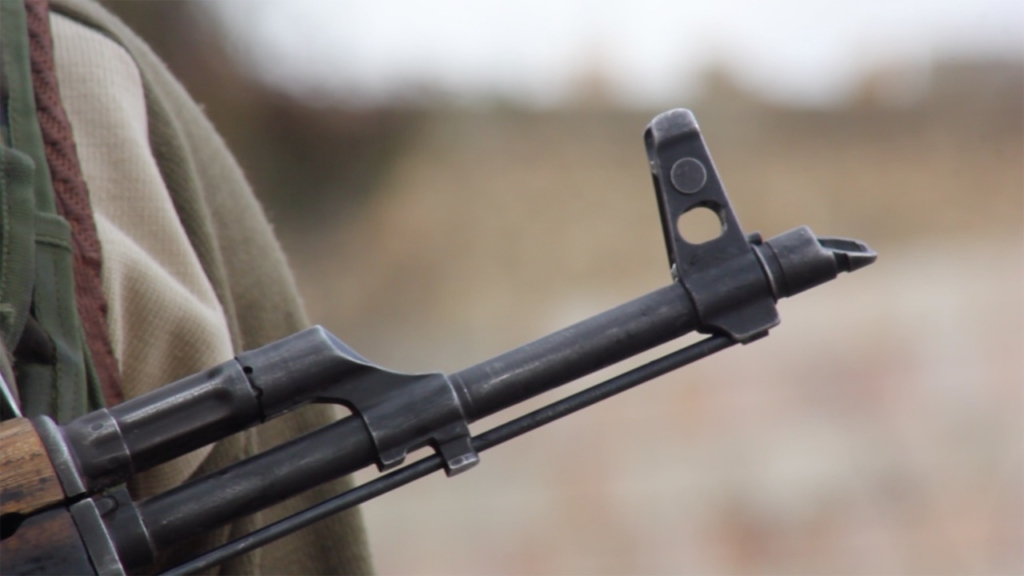
“Say I love you, or I will blow us both up with this bomb”, What love?!
This is Fatima’s story. It is not a scene from a movie. Fatima is a young Syrian woman who was married to one of her relatives – a state of affairs not unusual in the Idlib countryside. Ten days after the wedding he came to her carrying the bomb, asking her for a declaration of unconditional love. Neighbors heard the commotion, and they saved the girl. The scene was repeated many times, so Fatima decided to avoid death despite the suspicion that she cheated on the husband. Nobody would be convinced that her husband would kill her because she abstained from declaring her love under armed threat. The bomb-holder did not stop after the divorce. He turned Fatima’s life into a living hell. “He threatened to kill my family when I remarried. He assaulted us at our house, and if not for the intervention of the Free Police Force, that detained him for a single night, we would have been dead”, said Fatima, “The Police do not have the mandate to process such cases in a substantial manner”.
“I felt I would die the day he had that triggered bomb hovering over my head. I survived a life of bitter struggle”, said Fatima, “but so far he is challenging my remarriage under threat of his weapons, and threatens that he will kill whomever asks for my hand. I went on however and remarried, and only my family knows about this. He discovered this, and set up a checkpoint at the outskirts of town, to kidnap the person who asked for my hand. He did not stop at that, so I sought intervention from his close relatives who condemned his actions”. Fatima’s situation was resolved through the judiciary, associated with the military faction that her divorcee works for, not through family interventions. And so, she remained unmarried under his armed threat. Fatima’s siblings could not keep him away from her and her life. “What is this forest we live in?” She concludes her story. Her story is not unique in Syria, after eight years of bloody conflict.
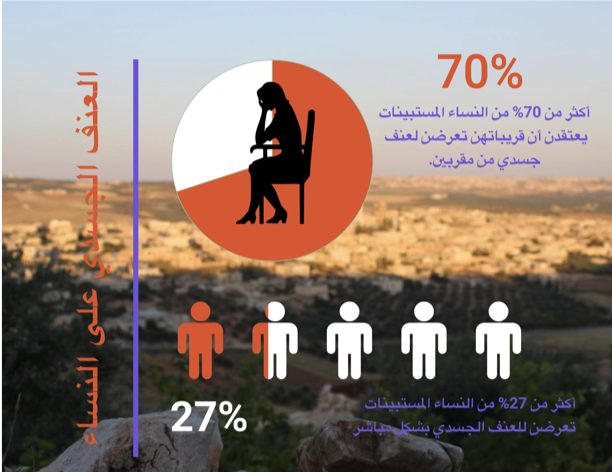
Physical violence against women – 27% – over 27% of surveyed women faced direct physical violence – 70% – More than 70% of surveyed women think that female relatives suffered physical violence from persons close to them.
.
A “little-Syria”
We consulted 202 women in Ma`r-Taharma, Fatima’s town. The town was treated as a indicative of wider Syria. This town, of over 20,000 people, include 5,000 Internally Displaced People from northern Hama Countryside, Idlib Countryside, and other areas in Syria. Ma`r-Taharma witnessed the passage of several militant groups over time. In late 2011, young men from town established the Dir’a al-Islam [Islam’s Shield] Brigade, that became a satellite force following several militias and powers over the following years, the last of which was the Hazm Movement militia. The Sham Liberation, as Nusra used to be known, expelled all forces that opposed it from the town, and has controled it for two years so far. A strong state of militarization has been expressed in the widespread phenomenon of personal weapons.
80.7% of the surveyed posses firearms in their homes
The randomly sampled survey’s results about violence and reactions to it have proven consistent. 27.2% of the sample, like Fatima, had the courage to come out and say they faced physical violence by their male relatives. 70.3% stated that females they know witnessed physical violence at the hands of their male relatives. We notice that many married women abstained from stating the violence they faced, whereas they confirmed that women close to them faced such violence. Social factors played a central role that appears clearly in the answer to the general question on violence against women, as 71.8% of the surveyed women confirmed falling victims to violence, in the town.
“I am considering suicide”
While Fatima has some family to care for her and support her in her divorce, Um Muhammad, who fled to the town from Hama, is away from her family. “When he pointed his weapon at me, my daughter shielded me with her body. If he had pulled the trigger, he would have killed us both. She’s always concerned about me because she’s my only daughter. She dreams of going to school, and to become like her peers. Our poverty, however, stands in the way of her dream”. In a nutshell, this is the relationship between Um Muhammad and her husband, who emerged psychologically destabilized from the Syrian regime’s prisons recently. His uses his son Muhammad’s weapon to inflict the most violence during his fits of anger. Later, he usually apologizes.
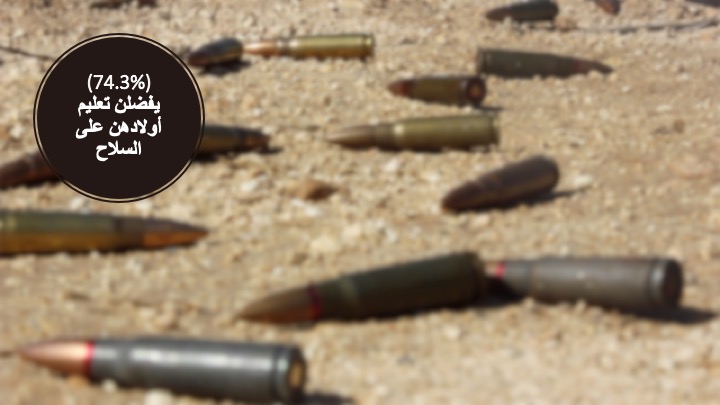
74.3% of women prefer educating their kids to having weapons.
“We had a fight yesterday. He beat me. He then assaulted me with my son’s weapon. If the neighbors didn’t intervene, he would have killed me. He might do that at some point. In the past, he took aim and shot at the kids. But thank God, nobody was hurt. He has beaten me for the last five years, and he always threatens me with the weapon. He thinks I am the reason behind his detention. After getting out of prison he’s not the same anymore, a different man. He lost his job, his income, and ability to run the household. He became extremely violent”.
The presence of the weapon in Um Muhammad’s house is a means of livelihood. Her son works for militias for a monthly salary that barely covers basic needs, like so many other young people. However, 74.3% of surveyed women declared their preference for investing in their kids’ education, not in firearms. The weapons that became a tool of violence against them, are simultaneously a means for their livelihood.
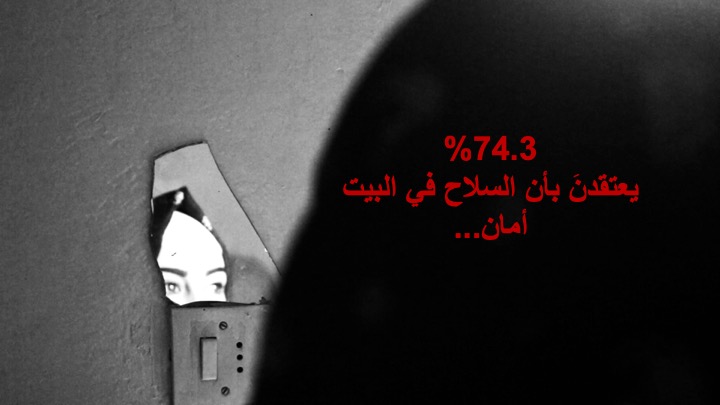
74.3% think that weapons at home provide safety.
Um Muhammad is contemplating suicide. She has been suffering domestic violence for years now, but recently that violence took a grave turn in the presence of the firearm. Um Muhammad, like so many other women, is “trying to come to terms with feelings of helplessness evident in the answers of surveyed women, who considered firearms useful as a means of self-defense. But, again, like her peers, she sees that the arms proliferating in households around her are at the same time the very reason why insecurity is sustained”. Perhaps this statement from Psychiatrist Bassam Awel summarizes the significance of the survey’s quantitative results. Perhaps the statement sums up the situation Syrian women face at the moment. Awel added, “In wars in general, the situation of females and children deteriorates, because they are the most vulnerable link in the chain, in comparison to males. They often become firewood for the ragging fire of war”.
“The great majority of answers on the question of what women would do if they face military assault were either to flee or ask for help”, Dr. Awel continues his analysis, “On the other hand, their answers to the question of the security arms provide at home show that 74.3% of the sample think that weapons at home provide security”.
It is a security that turned into a new mode of violence against women, and a fatal potential error that lingers over the heads of some of them. It is an error of the kind that disabled Lamar’s life for years and left her with a permanent disability. “My cousin shot me with two bullets. The first fractured my hand and the other damaged my foot nerves, besides tearing at my colon, destroying the pelvic area on its way”. Lamar, in these straightforward few and simple words tells the story. Lamar was lucky to escape death. Um Abdou, however, died when her daughter shot her.
“Um Abdou was helping my daughters-in-law baking inside the house. I heard the shot, close to where I was. I entered the room to find my wife drenched in her blood on the floor. I held her, and took her to the hospital, but she was dying. She died instantly. My daughter, 12-years old, came with me, crying loudly, “It was me who shot her”. Then I knew she was playing with the gun that a neighbor left at our house, and killed her mother by mistake”, so says Abu Abdou, telling how his daughter, who got married later on and left town, shot his wife. The father declined our request to ask his daughter about the accident. Nobody knows the suffering she has been experiencing since then.
Um Abdou died in late 2012. She lost her life in a few minutes. “After the accident I banned all kinds of weapons from our house. We lived together for 40 years, and suddenly I lost her”, says the husband. Of course Abu Abdou didn’t report the accident, like so many other comparable cases.
Courts… but
“On my watch we didn’t see reports of accidental cases of shooting at women. We had seen some cases of intended homicide, but no manslaughter cases came our way, although we know they are many”, says Muhammad, who works for the Sharia court of southern Idlib Countryside court.
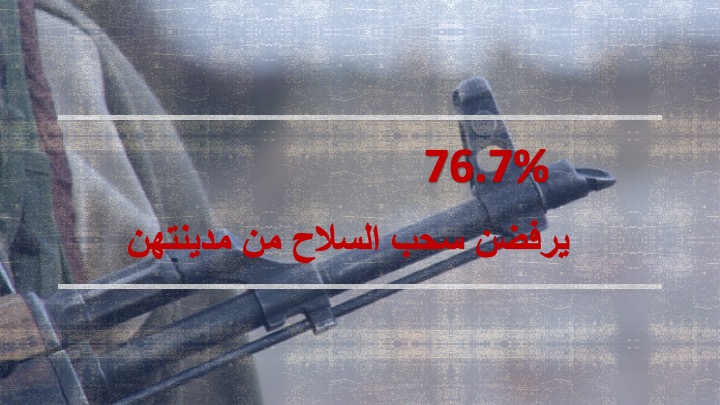
76.7% oppose the withdrawal of weapons from their town.
What’s the solution then? In the context of a conflict where many forces of different nationalities, ideologies, trends and goals take part? It is a war with no law ruling over it. It has produced a very complicated life in Syria. Ma`r-Taharma sums it up: it is a town full of weapons and fear of the future. Hundreds of displaced people reached the town, and hundreds more fled it. With this, it is not very different from so many towns across the countryside of Homs, Hama, Idlib, Aleppo, Damascus, and other parts of the country. Therefore, 76.7% of women in Ma`r-Taharma declared that they oppose having a town free of weapons, because they fear attacks from the Syrian regime or any extremist militants.
According to the surveyed women, weapons remain a source of safety. They ignore, in that answer, the link between firearms and the violence they face. The rifle, however, became a new way for expressing male violence against women. It is a violence that Dr. Awel thinks is deep-rooted in these communities, that suffer from “an ideological armed conflict that the women surveyed, like other women in other parts of Syria, suffer from”. This, according to Awel, “absents the relationship between making the town weapons-free and a downward trend in violence against women”. Therefore, [sic] it is not possible to compare levels of violence against women in Syria at the moment, to those levels before the war, in the absence of earlier statistics in that regard.
